-
Content count
183 -
Joined
-
Last visited
Posts posted by Cloud Dancer
-
-
A little off topic but, I just bought an engine for the model 2. A Hirth 3202 fuel injected 55 hp that can be upgraded to a 65 hp engine. Only has 30 hours or so on it. Engine is complete with exhaust, engine gages, all componets for the fuel injection system within 30 miles of me. Uses same mount as a 503 on a Kitfox. Which was the original engine it was licensed with. Weight is around 110 lbs with everything. Got it for 1/4 the price of a new one. Now to look for or build a mount.
That sounds like a hell of a good deal! Hirth have a good record and I like the fuel injection since it gets rid of many of the problems caused by carburetors being leaky or not adjusted properly.
-
Just found some more info that may be helpful to you in getting the registration cleared up. I found that a sale of your plane had been reported to the FAA to a guy in Bonsall, California. If he was the guy it was seized from for nonpayment of hangar rent, your bill of sale from the Sheriff's office could be all you need to transfer it and get the registration reinstated. JImChuk
Thanks for the information but there lies the rub; the guy in California is not the guy that had it before the Sheriff's sale. The previous owner listed at the Sheriff's sale was Jeffery Tyler Knowles. I tried to track down the guy in California and now have an old address. I'm not holding my breath on him being alive and having any paperwork though.
Below is some information I got from the FAA.
-
I use an old medical vacuum pump. I hook the hose from the pump over the bleeder fitting and turn it on. I then crack open the bleeder an 1/8 to 1/4 turn. Then I constantly keep adding fluid to the reservoir to replace the fluid getting sucked through the lines. If I let it get too low it sucks in air and I have to start over. After a cup full of fluid shows up in the vacuum pump's jar I shut the bleeder while the pump is running. If I open the bleeder too far it sucks in air around the threads on the bleeder fitting. The vacuum pump is just like my diaphragm air brush compressor; the only difference is the inlet and outlet are reversed. Now that I know how they work I'd bet you could take one of those small 12 volt diaphragm air compressors that are sold for filling tires on cars and reverse the inlets to make one. The collection jar was broke years ago and replaced with a mason jar. Bleeding brakes has been a piece of cake since I bought that $5.00 used pump.
-
Nice looking cone. Keep your eye's peeled for a used Shop Smith. I see at least 3 a year being offered for less than $300 bucks and most have all the add on tools. The last one I seen on Craigslist was being offered for $150 dollars. I'm tempted to get rid of my old drill press and put an older Shop Smith in it's place just to have the variable speed on my drill press.
-
Here is a link to an after market cylinder that's a replacement for one used in one of the Austin Healey cars: https://www.wilwood.com/MasterCylinders/MasterCylinderProd?itemno=260-6087 You could always call or email the other supplier and ask for length. My current Austin Healey now has a rebuilt original master in it and it's a completely different animal as the clutch and brake cylinders are built into the same casting. The replacement I had taken out of it was from a newer model and had the separate master cylinders.
I was tempted to look up the replacement master cylinders for the Honda Goldwing I sold a few months ago as that weighs even more than our airplanes and it's braking is also applied to just two wheels. Those cylinders are also small in size and effective.
The slave cylinder I mentioned is shorter than my hand, I'd guess about 4 or 5 inches long but I'd have to crawl under the car to measure it or hunt through boxes to find the spares.
-
An old machinist here. My eyes are getting bad but it sure looks like a little over six thousandths on my computer screen.
-
Looks a lot like what I did, except I changed to an external reservoir and the shortest cylinders matco makes (4g or 4h), and made the cylinder connection right above the pivot point. It gave me the 2.5x mechanical advantage Matco recommends, and went from barely able to hold the plane at idle (with the 'intensifier' kit in the old 5 cylinders), to holding it at full throtttle. Avid Model C, 582, original Peery prop
Mark
Matco makes nice stuff but it's way over priced just because it's going in an airplane. The master cylinder in my Austin Healey has the same bore and almost the same stroke and overall length as some of those Matco cylinders for a lot less money. Someone would have to get creative to mount them but at $19.47 each you won't be out much money. There are after market versions with different bore sizes for $53.00 each. Here's a link if you want to see what they look like: https://www.bpnorthwest.com/brake-master-cylinder-bn7-bt7-bj7.html
Another cheap option would be to adapt a clutch slave cylinder as a master cylinder such as the one on the Austin Healey Sprites and MG Midgets as seen here: https://www.bpnorthwest.com/clutch-slave-cylinder-1275-sprite-and-midget.html I've never seen a slave cylinder used as a master but it has a spring return and about the right amount of travel. It is way smaller and lighter than anything I've seen in most airplanes. I've got one or two of them laying around somewhere. They are a piece of cake to rebuild too.
I'm just thinking outside the box for the creative minds trying to save a buck.
1 person likes this -
I guess I should add that the book I linked to also contains information on lamination of various materials to form composites and then goes into testing the strength of those composites. Whatever method of repair for this damage can easily be performed on a piece of scrap of the same material and size and then tested for failure by mounting it in a vise and applying weight to it until it fails. Do the same test with a short sample of regular undamaged spar and see which one is stronger. These airplanes are called experimental for a reason.
I've got another airplane hanging about ten feet from me as I type this that most of you have never heard of. It's called a Ritz Standard. The original designer was killed in his design. The design was improved and sold for awhile but the new owner of the design pulled it off the market. My point is that just because somebody designed something a certain way does not mean it's the only way to do something. Much of his design lives on in other aircraft.
-
-
I'm not sure what's missing on your wood lathe? Not much to them. Some people take the head and tail stock off old wood lathes like yours and make riser blocks to raise the head and tail stock higher above the bed. It will give you enough clearance to use them as spinning lathes. Most patterns are made of hardwood but if your only making a few, I would think the particle board pattern would be just fine. I've got some old cd's purchased years ago on metal spinning but I bet there's plenty of You Tube videos on the subject today.
I've got a CNC lathe to turn the plugs with so I might try to do something like that down the road. Most patterns for turning are made in a couple of sections so you can get the plug out but a nose cone plug looks like it should pop out easy enough.
Those Shop Smith's are nice tools for small shops. They can be found cheap on Craigslist quite often, especially the older models. Many times I have been tempted to buy one when I see them on Craigslist and at estate sales.
-
I'll be attempting something similar trying to get mine registered. I think it's all about the money. Once they have the proper paperwork in their hands then they can go back and collect tax from all the previous owners that failed to register it. I'd rather they just give us the option to either track down all the previous owners or pay all the back taxes ourselves. Many would rather pay the piper than track down ghosts of the past.
Now that you got it widened out your seats are going to be too small. Does that use a sling seat like my Avid or did it have the fiberglass seat pan? Your doors won't fit either, new doors or widen out the old ones?
-
- I too would like to see how the new Avid metal tanks are built and mounted. Poly molded off the shelf tanks with some kind of floating mount sound easier and cheaper to source and won't break down from alcohol like fiberglass tanks. Here in the Midwest finding fuel without alcohol is getting harder all the time.
-
You might have better luck finding an Avid Flyer with tricycle gear such as the one I purchased a short time ago. Look for both to increase your chances. There's a Kitfox on floats up on E-Bay right now that I would be bidding on if I didn't have the Avid. It's got a set of gear legs with it but no wheels. While I'm good at building; I much rather fly than build and the one on E-Bay is less work to get in the air than mine. Here's a link: https://www.ebay.com/itm/1992-Kitfox-2-on-Aerocet-Floats/264056628244?_trksid=p2485497.m4902.l9144
1 person likes this -
Splicing spars with a piece of tubing the next size smaller is common practice in the ultralight world. The splices are very much like the method used in the extension diagrams referred to earlier in this thread. We sometimes double sleeved the joints by using a piece of tubing the next size smaller than the splice. If the end of the spar had a hole in it at an attachment point we would also glue in a piece of hardwood dowel to prevent compression at the connection point. A book covering the build practices can be ordered here: http://www.beaujonaircraft.com/
It's got some great information in it but it's only worth the $10 or $20 dollars I paid for it back in the 70's. Full length spars would be expensive so splicing shorter lengths has been common practice for decades. Many of those early ultralights turned into many of the light sport aircraft that are still being sold today. I'd smooth the outside as mentioned earlier and sleeve it inside. You can always add a layer of fiberglass inside, outside or both if your really worried. Look up Glare for information on composites made of aluminum and fiberglass epoxied together. I think this is overbuilding but sometimes it's needed to afford some people piece of mind.
-
I have posted this before, guess I will do it again.
This came straight from the mouth of the designer when I talked to him (thanks Joey for putting me in contact with Dean). The aft CG limit that was listed is very conservative. Dean chose that because the original dream was to have a plane a guy could build then learn to fly. A nose heavy airplane flies poorly, a tail heavy airplane flies once.. Dean stated they had tested back to 21" but cautioned me to not stall it at anything further back than 20" unless you had full flaps in as the tail would drop and you would not get the nose back down. I personally like to fly mine at 16-18". Yes it flies better, gets off the ground faster and actually does land slower. I can fly at neutral elevator trim instead of full nose up trim if I fly it a more forward CG. This equates to less drag, more speed, better climb and a much better handling airplane.
You can sit at the keyboard and argue thoughts all day long, but until you actually get out and do it yourself its nothing but hearsay. I personally HATE the way the plane flys at the forward CG range. Its a slug compared to the more rearward CG. I have loaded mine to the point that full nose down trim was not doing the trick anymore and I had to pull in about half flaps to keep the tail up. Was not the worlds best feeling and I damn sure didn't slow the bird down, but it got the load to the remote island I was heading for and delivered a hell of a load of groceries, beer and sodas.

Now that's a post that I say makes perfect sense! It's just a matter of applying and understanding the very basics of aircraft design. Model aircraft follow the same rules. Most designers have dabbled with models and many still do. Don Mitchell was a skunk works designer but he started with models. The flapperons on your Avid are nothing new; Don had put them on his Mitchell Wings long before the Avid came around. Don didn't invent the concept either; he got the idea from the German designers that used the upside down wing design for control surfaces in WW2 on some of their designs.
If you want to play with CG and get quick results; try a flying wing. I've got an Easy Riser, a T-10 Mitchell Wing and a B-10 Mitchell Wing. (all flying wings) I traded my world record holding A-10 Mitchell Wing back to the factory for the T-10 two place. I wanted the extra seat and the factory wanted the altitude record holder airplane. The CG is so sensitive in a flying wing that you can move your head forward and backward and control pitch.
-
Cloud Dancer,
The CG range is not really a tolerance band, like + .010" is a tolerance. The difference is that the airplane can operate across a wide band of speed, weight, altitude and CG, and none of them are tolerances, they are approved operating envelope areas, each with a horror story if exceeded.
The forward CG limit is found by testing the aircraft at slower and slower speeds in landing condition, until the up elevator is no longer able to hold the nose up. This is because the up elevator is fighting the nose down tendency of that forward CG, and as speed reduces, the force the elevator can make to fight the nose down is reducing. Another possible way that forward CG can be limited is by crash loads, which stress the gear unevenly as the weight is shifted across the CG range, especially a nose wheel in a nose dragger.
The aft CG limit is chosen almost the same way , but in that the elevator cannot stop the nose from popping up as the landing is made. If you fly an Avid at its aft limit, the nose in a landing flare tries to go to the sky, it is a spooky feeling. Some have said aft CG makes the airplane land slower, which is not correct, but aft CG does make the aft stick needed for high angle of attack (slow landing) much easier to get too. Another limit for aft CG is the ability to get out of a spin, because as CG gets further aft, the spin gets flatter, and the forward stick to recover gets less effective. Far enough aft CG and a stall can easily become a flat spin, where recovery is impossible. Test pilots put a spin chute in the tail and pop it out to make the spin stop if they go flat - a wild ride!
Totally disagree with almost everything you wrote. The only information gleamed from your comment was the tail chute trick and I can see being even more dangerous than the flat spin! If it were implemented correctly, not too big or small and had a way to dump it completely, then a spin chute might be of some use but I don't see it catching on within general aviation aircraft designs.
In the simplest terms possible; our airplanes trim out and fly exactly like a 10 cent balsa glider that most kids played with at one time or another. Forget to put the weight on the front and they don't fly at all! (tail heavy) Put the weight too far forward and they fly fast and straight but fall out of the sky as soon as the throwing energy starts to diminish. Get the balance point correct and they launch nice and continue to fly even when the launch energy is gone. They continue to fly all the way back to earth and land smoothly. Somewhere in between these two extremes lies your CG range.
-
I think the broken side would have a tendency to develop flutter which could easily result in partial loss of control.
-
Cloud Dancer, You mention fabricating a new tail wheel assembly. Just a heads up, if you end up switching to tailwheel, the mains you have now will not work. The main wheels end up to far rearward. I know of someone who did that and the first time they revved up the engine, the plane went over on it's nose and destroyed the prop. When you get a chance, please post up some good pictures of the flaperon hangers. I know someone put aluminum brackets on the wings, like the Kitfox 4 and later have, and I would be curious to see close up what they look like. JImChuk
-
I noticed you also have an ad on Barnstormers in the wanted section. If someone has a broken hub and maybe a broken blade stump laying around; I'd be interested in those. I have a cnc machine with a touch probe. I might want to scan the old parts and then machine my own hub and blades.
Take care,
Brad
-
Sorry to hear I can't get a cowl at the moment. Anyone out there with an unused Mark IV cowl for sale? Anyone got an old broken cowl still laying around that I could repair? If I can't find one I will make one from scratch if I have to. My airplane is serial number 270, has the double radiator setup and a 582 gray head. Unable to contact previous owner to locate missing parts. Photo below to show what I'm trying to wrap a cowl around.
Thanks,
Brad
-
Did you ever find a source?
-
I'll second wrapping it with the high temperature insulating tape. I had a 1967 V.W. bug when I was younger. Any heat that the engine produced was lost in the ducts that ran under the car. I had to scrape the windows on the inside while driving it all winter. It never got more than 10 degrees warmer than the outside air with that poor design. Not even a heater fan on those cars back then. I added a fan from J.C. Whitney and gained air movement but it was nothing but cold air movement. If I was doing it today it would be insulating tape on all the duct work trying to save all the heat I can get. If you can duct the air coming through the radiator through your muffler heater it might even work better with the radiator serving as a preheat. How cold of weather are you expecting to be flying in?
-
I'd say take it to a local auto body shop, maybe one of the bigger ones that also work on semi trucks Our local body shop has a huge frame straightener and a couple of large presses. These type of shops are used to bending metal back to original shape and can do so fast and for a reasonable rate. Much cheaper than a new gear. Some even have huge ovens to stress relieve the metal after bending. Some shops might not want to take on an aircraft part but others have no problem with a simple tweak job like yours.
1 person likes this -
Fred, maybe you missed the video where Bryce was also adding weight to the tail even with the white colored landing gear featured in your photo above? In the video he clearly states his intent is to alter performance to get it to stall more like a Cessna. Nowhere has he mentioned it was to prevent nose over. Link to the video here: https://www.youtube.com/watch?v=jNVj_I_J5BY
Yes, I have previously read the designer notes you included in your last post. My 2 cents on that topic maybe belongs in a new thread but here goes. Being a machinist for many years I'm used to working with tolerances. Something to be made with a diameter of .995 to 1.005 is usually written as 1.000 +/-.005 or 1 inch plus or minus 5 thousandths of an inch. A 1.000 inch diameter part is what I would try to machine. To get to the sweet spot of your CG you also need to find the middle. 16.5 max minus 11.185 minimum is 5.315 and that number divided by 2 is 2.6575. That's your minimum and maximum deviance number when your CG is set in the middle. 11.185 plus 2.26575 is 13.8425 and that's very close to the 14 inches aft that Bryce mentioned in his reply above. I'm not quite sure how you are coming up with Bryce being close to the aft limit when he clearly states he's around 14 inches and that's almost perfect. If you wish I can convert to metric for you. Also keep in mind that there is a safety margin built in the numbers published in the book to keep the airplane stable within general aircraft guidelines. In reality those numbers are more for making the aircraft stall and spin resistant and recoverable in those situations. Since most people these days are not trained anymore in stalls and spins we try to put training wheel numbers in our figures to keep the average pilot safe. Not a bad thing but it can make a sensitive airplane fly like a bus.
Anytime your flying out of spec you are doing test pilot work without the hazard pay. Many groups today still argue over the possibility of flying a Cub solo from the front seat even though many are placarded against it. I mentioned my grandfather was a Great Lakes dealer, he also owned a Stinson and a Waco at some point. As a kid in the 60's I heard him tell me he liked the Champs over the Cubs because you could fly them solo from the front seat. Under some conditions they found the Cub would not recover from a spin. Everybody practiced stalls and spins back in the 30's, it was required to get your license. My point here is too weight ahead of the CG can be just as lethal as too much weight behind the CG. I have no idea how fully the Avid Flyer was tested under extreme ranges of it's recommended CG limits. Your reprint out of one of the manuals only applies to one version of the Avid Flyer with one set of wings and in one landing gear configuration. And even then the rearward limits were not fully tested, it was only tested to 14.562. It states flutter and stalls. One can pull a stall in an airplane that results in a tail slide and progresses into an inverted spin. I doubt those were attempted. Some airplanes that can recover from a stall; cannot recover from an inverted stall. Anything not listed in more details may or may not have ever been tested. Even if it was fully put through the paces during testing; no manufacturer wants the liability that could result from a customer trying something outside of his abilities. Also in your manual reprint the max fuel ever listed is 54 pounds. At 6.3 pounds per gallon that's only about 8-1/2 gallons. Hardly a true test of spins at full stress numbers. Anyone getting into a spin without wanting to is probably going to have more fuel on board.
I'd still like to see measurements comparing the arm length from the datum point of the tricycle gear attached in tail dragger configuration and the original Avid Flyer model A when it was first setup as a tail dragger. Someone in this group from Idaho may want to ask the original designer the next time he bumps into him.

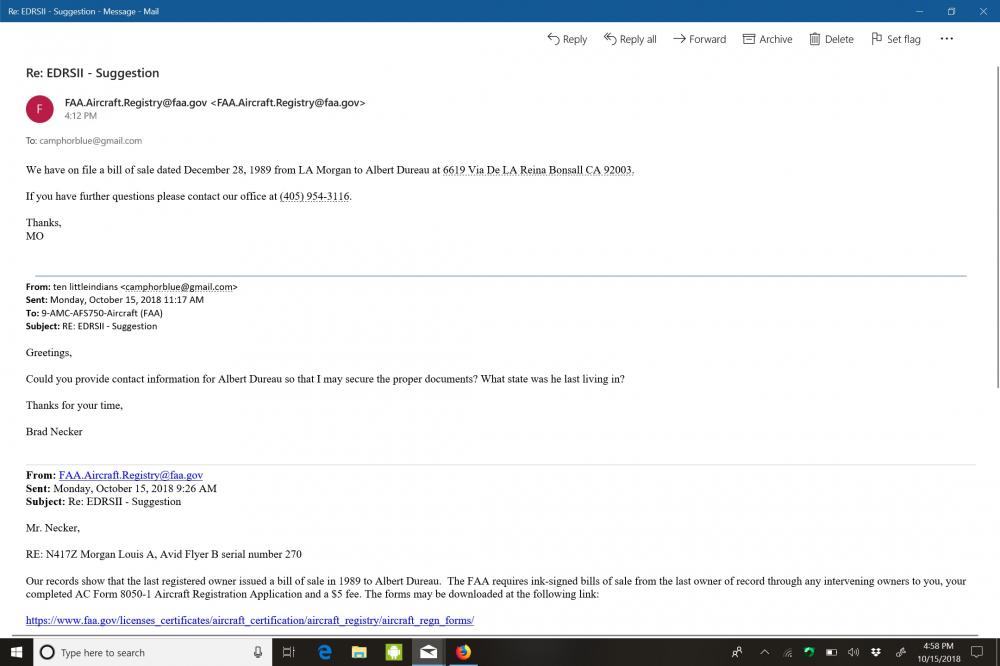
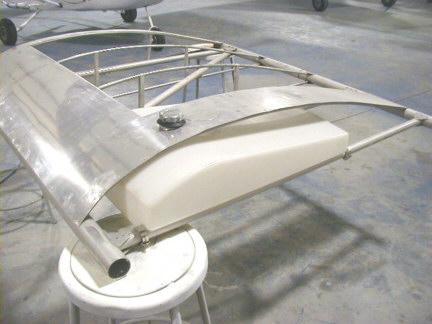
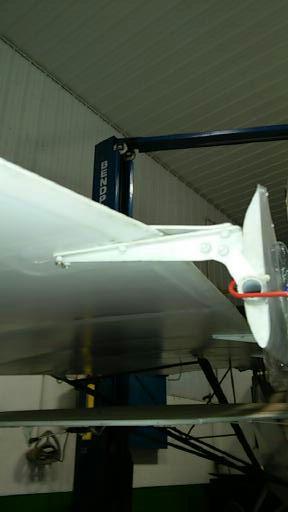
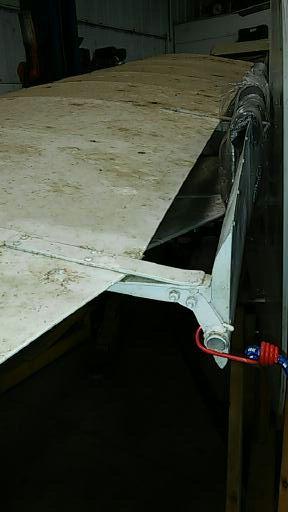
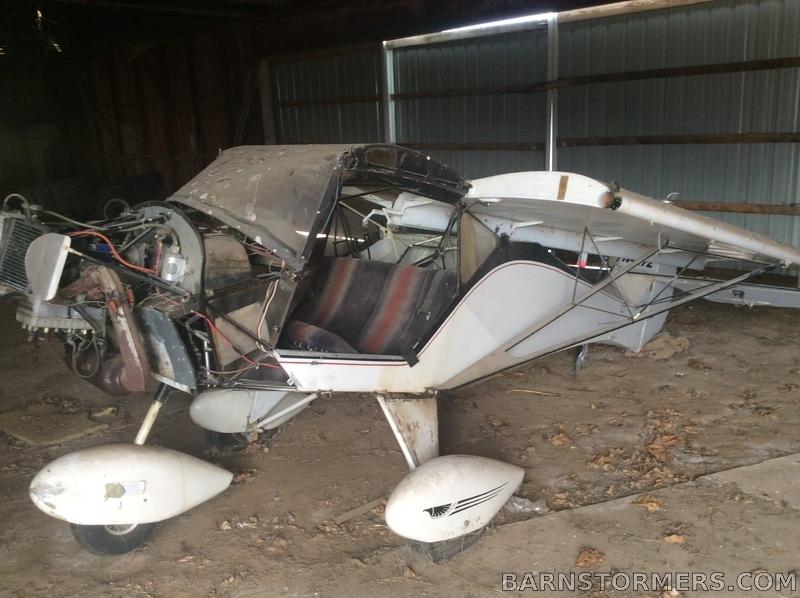
W&b doneso
in Avid Model C
Posted · Edited by Cloud Dancer
Too bad it's not easier to shorten up the engine mount. What's the rim made out of on your tail wheel? If it's aluminum maybe you can find a steel version to add a couple of pounds in the back? An added advantage of a heavier tail wheel would be the inertia needed to get it spinning would result in a braking effect on touch down. Of course you get the opposite effect once it's up to speed and then your trying to slow the airplane down. I don't like adding weight either and if I do have to add any I'd like to figure out how to get some use out of it. In my case I'd probably just mount my B.R.S. chute further back in the fuselage.
If you want be unique in adding weight to your tail, I'd suggest a tiny set of bomb bay doors in the back containing a small stuffed animal fox in a leather bombers jacket and parachute. You could drop him at your friends house. In my case I'd probably use it to drop off a friendly canned drink by parachute. My friends get thirsty from playing all day in the summer sun on the Mississippi river and the sand bars.
We had a guy in our ultralight club we called "The Candy Man". He always made a low pass over after take off and threw out candy from his Kolb. The kids loved hunting the candy down in the grass.